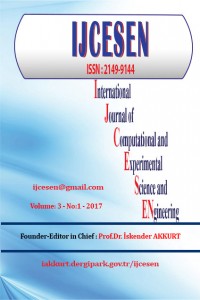Araştırma Makalesi
Yıl 2017,
Cilt: 3 Sayı: 1, 7 - 10, 28.06.2017
Öz
Risoe
wind turbine is a 100 kW horizontal axis wind turbine developed by Denmark
Technical University National Laboratory for Sustainable Energy to be used for
field testing purposes. In this paper, the chord and twist distributions of
Risoe wind turbine blades are optimized so that the power production of the
wind turbine is maximized. To constrain the mass of the wind turbine blade, the
projected surface area of the blade is constrained by its original value. 18
design variables are used to describe the chord and the twist distributions of
the blades. The upper and lower bounds of the design variables are taken as
130% and 70% of the original values of the design variables, respectively. The
fmincon function of MATLAB based on sequential quadratic programming algorithm
is used to solve the optimization problem. A response surface based approach to
reduce the computational cost. The optimization results show that the power
generated by the wind turbine is increased by 20% through adjusting the chord
and twist distributions. It is also found that the response surface based
optimization and direct optimization yield nearly the same results, whereas the
response surfaces reduce the computational cost by 85%.
wind turbine is a 100 kW horizontal axis wind turbine developed by Denmark
Technical University National Laboratory for Sustainable Energy to be used for
field testing purposes. In this paper, the chord and twist distributions of
Risoe wind turbine blades are optimized so that the power production of the
wind turbine is maximized. To constrain the mass of the wind turbine blade, the
projected surface area of the blade is constrained by its original value. 18
design variables are used to describe the chord and the twist distributions of
the blades. The upper and lower bounds of the design variables are taken as
130% and 70% of the original values of the design variables, respectively. The
fmincon function of MATLAB based on sequential quadratic programming algorithm
is used to solve the optimization problem. A response surface based approach to
reduce the computational cost. The optimization results show that the power
generated by the wind turbine is increased by 20% through adjusting the chord
and twist distributions. It is also found that the response surface based
optimization and direct optimization yield nearly the same results, whereas the
response surfaces reduce the computational cost by 85%.
Anahtar Kelimeler
Kaynakça
- [1] Burton, T., Sharpe, D., Jenkins, N., Bossanyi, E., “Wind Energy Handbook,” Wiley, New York, NY, 2001. [2] Hau, E., “Wind Turbines – Fundamentals, Technologies, Applications, Economics,” Springer-Verlag, Berlin, 2013. [3] Jureczko, M., Pawlak, M., Mężyk, A., “Optimisation of wind turbine blades,” Journal of Materials Processing Technology, Vol. 167, No. 2–3, 2005, pp. 463–471. [4] Wang, Q., Wang, J., Chen, J., Luo, S., Sun, J., “Aerodynamic shape optimized design for wind turbine blade using new airfoil series,” Journal of Mechanical Science and Technology, Vol. 29, No. 7, 2015, pp. 2871-2882. [5] Carrasco, A.D., Valles-Rosales, D.J., Mendez, L.C., Rodriguez, M.I., “A site-specific design of a fixed-pitch fixed-speed wind turbine blade for energy optimization using surrogate models,” Renewable Energy, Vol. 88, 2016, pp.112-119. [6] Snel, H., "Review of Aerodynamics for Wind Turbines," Wind Energy, Vol. 6, 2003, pp 203-211. [7] Myers, R.H., Montgomery, D.C., “Response Surface Methodology: process and product optimization using designed experiments,” Wiley, New York, NY, 2002.
Yıl 2017,
Cilt: 3 Sayı: 1, 7 - 10, 28.06.2017
Öz
Kaynakça
- [1] Burton, T., Sharpe, D., Jenkins, N., Bossanyi, E., “Wind Energy Handbook,” Wiley, New York, NY, 2001. [2] Hau, E., “Wind Turbines – Fundamentals, Technologies, Applications, Economics,” Springer-Verlag, Berlin, 2013. [3] Jureczko, M., Pawlak, M., Mężyk, A., “Optimisation of wind turbine blades,” Journal of Materials Processing Technology, Vol. 167, No. 2–3, 2005, pp. 463–471. [4] Wang, Q., Wang, J., Chen, J., Luo, S., Sun, J., “Aerodynamic shape optimized design for wind turbine blade using new airfoil series,” Journal of Mechanical Science and Technology, Vol. 29, No. 7, 2015, pp. 2871-2882. [5] Carrasco, A.D., Valles-Rosales, D.J., Mendez, L.C., Rodriguez, M.I., “A site-specific design of a fixed-pitch fixed-speed wind turbine blade for energy optimization using surrogate models,” Renewable Energy, Vol. 88, 2016, pp.112-119. [6] Snel, H., "Review of Aerodynamics for Wind Turbines," Wind Energy, Vol. 6, 2003, pp 203-211. [7] Myers, R.H., Montgomery, D.C., “Response Surface Methodology: process and product optimization using designed experiments,” Wiley, New York, NY, 2002.
Toplam 1 adet kaynakça vardır.
Ayrıntılar
| Bölüm | Makaleler |
|---|---|
| Yazarlar | |
| Yayımlanma Tarihi | 28 Haziran 2017 |
| Gönderilme Tarihi | 28 Haziran 2017 |
| Yayımlandığı Sayı | Yıl 2017 Cilt: 3 Sayı: 1 |


